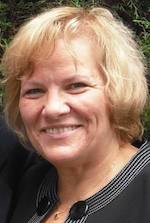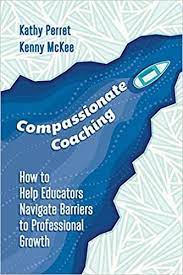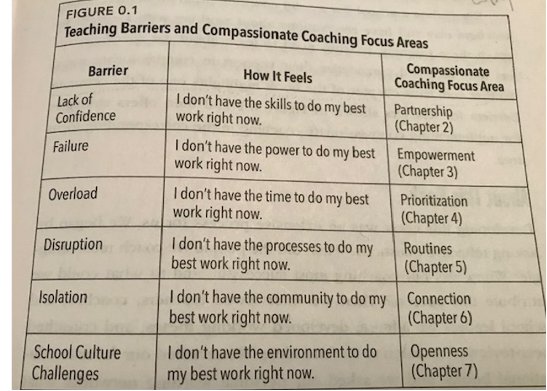Compassionate Coaching for Professional Growth
Compassionate Coaching: How to Help Educators Navigate barriers to Professional Growth
By Kathy Perret and Kenny McKee
(ASCD, 2021 – Learn more)
Reviewed by Helene Alalouf

The answer: The design thinking process combined with continuous and responsive support that brings wisdom and context to the change process.
This answer came to me when circumstances converged inexplicably yet in a timely way in the same week.
I attended a math coaching mastery webinar organized and facilitated by Digital Promise’s Community for Coaches to overcome well-known barriers. And then this gem of a book arrived in my mailbox – Compassionate Coaching: How to Help Educators Navigate Barriers to Professional Growth.
The universe seemed to acknowledge that I – a lifelong educator like you – will face “barriers to professional growth” in myself and in those we mentor. We all need an empowering process and substantial conversations to work towards solutions.
Relationships Matter

Coaching is most gratifying when teachers we partner with achieve success in implementing a strategy that enhances their explicitness or nurtures student engagement. Positive growth occurs as “…good coaches foster supportive and productive relationships that improve student learning” (xvi) by through the use of GPS:
● G=Goal: Co-constructing our goal for student learning and/or instructional practice, articulated as SMART learning targets which are critical for effective classroom-based coaching cycles.
● P=Plan: Planning strategic and focused daily actions so we are better aligned to our priorities. This implies data-informed ACTION (p.38-39) for both the teacher team and the coach, such as a Student Achievement Plan (p.41).
● S=Steps: Monitoring our Steps with autonomy and responsible accountability in classroom-based coaching cycles.
Written during the Covid pandemic, this toolkit for inside-out professional development uses a strengths-based appreciative inquiry strategy to understand and develop the partnership and professional learning – fueled by core competencies like those identified for students by the Collaborative for Academic, Social, and Emotional Learning (CASEL) to overcome temporary situational barriers with appropriate methods and instructional strategies.
The book is dedicated to all of us, “to the coaches in our own lives, formal and informal, personal and professional, who supported a growth in the ways that matter, built our confidence, and coached us with compassion.“ (Frontpiece)
And aren’t all of us – as educators, parents and friends – coaches? Aren’t we all entitled to support each other to be the best we can be?
Planning the Itinerary
To quote the authors: “As Saphier and West (2009) write, ‘Many teaching problems begin when teachers don’t anticipate student confusions, can’t figure out how to scaffold needed prior knowledge, and don’t carefully think about experiences that would allow students to access new knowledge. In other words, many teaching problems begin with inadequate and unskilled planning.’” (Cited p.11)
Likewise, good coaching requires time for reflecting and planning for lessons and collegial conversations with individuals and PLCs, researching resources, developing formal professional learning sessions, nurturing teacher leaders with inter-visitations and learning walks, and many other duties (p.57).
While claiming that “Planning with the coach has more potential for improving instruction than any other activity,” the authors advise that modeling and observations require co-constructing look-fors and other note-taking tools, setting up a reflective debriefing meeting ahead of time, using simple protocols and established routines for lesson study, examining student work or observation data, focusing on what is best for students and how to solve instructional challenges (pp.13-16).
“Examples of issues that can benefit from classroom observation during the coaching cycle include lesson pacing, differentiation and equity, student engagement, questioning, opportunities to respond, student collaboration, and classroom routines” (p.14).
Supporting Roles
Based on the research about effective professional development by Joellen Killion and Cindy Harrison (2006), the authors cite 10 distinct roles that teacher leaders and coaches play in offering support: 1. Resource Provider, 2. Instructional specialist, 3. Curriculum Specialist, 4. Classroom Supporter, 5. Learning Facilitator, 6. Mentor, 7. School Leader, 8. Data Coach, 9. Catalyst for Change, and 10. Learner.“
Compassionate coaching employs those roles by focusing on areas to overcome teaching barriers:
Be a Strengths-seeker!
● What helped you learn today?
● What got in the way of your learning today? (p.35)
The significant learning for me was threefold: refreshing my understanding of design thinking; reframing negative thoughts positively; and empowering and informing teachers by offering them choices on a coaching menu (p.81, 94-95)
What got in my way was following all the phenomenal links and resources: these “time thieves” consumed hours; however, such abundance is manageable with the WSN framework’s three key questions:
● What are the key points?
● So what is so important about them?
● Now what steps do I take to put them into practice?
Try WSN with the following selections from this toolkit.
● Twitter hashtags for educators and Global Coaching on Twitter with the authors every Wednesday at 9pm EST.
● Myteachsource.ascd.org
● Math Language Routines
● Lesson plan templates from hyperdocs.co
● Adrienne’s free yoga routines on YouTube
● Appreciative inquiry, Barriers or bridges, Consultancy, Affinity and so many more protocols from National School Reform Faculty available at https://nsrfharmony.org/protocols
So now that I have shared the key points and why these are important, what steps will you take? If you’d like to learn from and with colleagues, I highly recommend you apply any of the effective suggestions and protocols in this professional companion.
Compassionate coaching causes us to reflect on our practice and deliver planned actions to shift everyone’s performance. Let’s navigate and overcome the barriers together.
Since attaining her Masters from Teachers College, Columbia University, and later National Board Certification, education consultant Helene Alalouf relishes opportunities to share her passion and informed fluency of research-evident principles to ensure a productive learning environment, cognitively and affectively, to support educators and families in realizing their vision. At leisure she enjoys walking and cooking with family and friends, reading, and knitting.



































